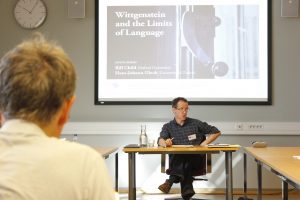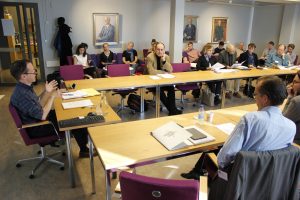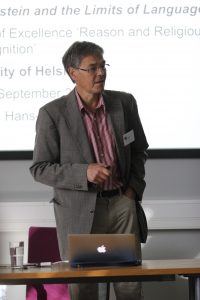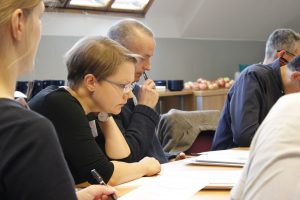Text by Hanne Appelqvist, photos by Heikki J. Koskinen
When asked what jazz is, Louis Armstrong replied “If you got to ask, you ain’t never gonna get to know”. Is there something – a limit of language – that defies our attempts to express in words what it is? That was the question that brought to Helsinki a group of Wittgenstein scholars to discuss the nature of logic, grammar, linguistic frameworks, relativism, thought, and consciousness in the attempt to get clearer on what Wittgenstein means by his references to the notion of a limit of language. Can we use language to get outside of language – a question explored by Bill Child’s keynote address? Or is our sight limited or conditioned by the grammar of our language, even if that grammar is of our own making? Or is the idea of, for example, ineffable conscious states (of humans) a merchandise of new mysterianism, to be demystified by proper conceptual analysis, as argued by Hans-Johann Glock in his keynote address?
The notion of a limit is of Kantian origin. For Kant, the goal of philosophical investigation was to determine the necessary, limiting conditions of different types of judgment. As early as in 1960, the Finnish Erik Stenius claimed that there was something similar going on in Wittgenstein’s early work Tractatus Logico-Philosophicus. According to Stenius, the early Wittgenstein aimed at showing that logical form is the necessary condition for the possibility of language and therefore cannot itself be expressed by linguistic means. Just like the jazz tune that displays its own form, so too the propositions of language – that themselves say something about the world – simply show the form that makes saying possible. Hence, Wittgenstein writes, “Logic pervades the world: the limits of the world are also its limits” (TLP 5.61). For Stenius, this did not mean that the philosopher could not reflect the limits of language from within, only that no viewpoint from without will present itself. Nevertheless, this view leaves open how exactly we are supposed to understanding the relation between language and the world, a question treated by Colin Johnston’s paper on Wittgenstein on Representability and Possibility. And what to make of the subject of language – Wittgenstein’s early ‘I’ of the ‘I think’ or his later ‘we’ of ‘this is what we do’ – notions that got an in-depth examination in the papers given by Jakub Gomulka, Adrian Haddock, and Constantine Sandis?
In Wittgenstein’s later work, the question of a limit of language becomes associated with the possibility of justifying the application of a rule of language by conceptual means. This question was put on the table already by the opening keynote address by Child, suggesting that the norms of language could be seen as supervening on the non-normative facts of our practices. Further illumination of the issue was offered by papers that placed Wittgenstein’s thought into a wider context, relating it to the positions of Carnap and Moore, discussed by Leila Haaparanta, Suki Finn, and Yrsa Neumann, as well as to the contemporary debate on relativism, addressed by Gurpreet Rattan. The likely candidates of ineffabilia in Wittgenstein’s thought, namely, aesthetics, ethics, and religion, received attention in the papers by Willie van der Merwe & Tony Pacyna as well as Eran Guter, who called for a new evaluation of the role of music in Wittgenstein’s philosophical development. If the understanding of language is more like the understanding of a musical thought, then what is the lesson we are supposed to draw from this? Was Louis Armstrong in agreement with Wittgenstein, who said about aesthetics: “A solution must speak for itself. If when I’ve made you see what I see, it doesn’t appeal to you, there is an end” (M 9: 31).




